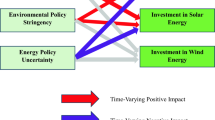Abstract
The purpose of this paper is to provide a quantitative analysis of innovation and diffusion in the European wind power sector. We derive a simultaneous model of wind power innovation and diffusion, which combines a rational choice model of technological diffusion and a learning curve model of dynamic cost reductions. These models are estimated using pooled annual time series data for four European countries (Denmark, Germany, Spain and the United Kingdom) over the time period 1986–2000. The empirical results indicate that reductions in investment costs have been important determinants of increased diffusion of wind power, and these cost reductions can in turn be explained by learning activities and public R&D support. Feed-in tariffs also play an important role in the innovation and diffusion processes. The higher is the feed-in price the higher is, ceteris paribus, the rate of diffusion, and we present some preliminary empirical support for the notion that the impact on diffusion of a marginal increase in the feed-in tariff will differ depending on the support system used. High feed-in tariffs, though, also have a negative effect on cost reductions as they induce wind generators to choose high-cost sites and provide fewer incentives for cost cuts. This illustrates the importance of designing an efficient wind energy support system, which not only promotes diffusion but also provides continuous incentives for cost-reducing innovations.
Similar content being viewed by others
References
Baltagi B. H. (1995). Econometric Analysis of Panel Data. John Wiley & Sons, New York
Barreto L., Kypreos S. (2004). “Endogenizing R&D and Market Experience in the ‘Bottom-up’ Energy-systems ERIS Model”. Technovation 24:615–629
Bergek, A. (2002), ‘Shaping and Exploiting Technological Opportunities: The Case of Renewable Energy Technology in Sweden’, Ph.D. Dissertation, Chalmers University of Technology, Sweden
Berndt E. R. (1991). The Practice of Econometrics: Classic and Contemporary. Addison-Wesley, Reading, Massachusetts
Buen, J. (2006), ‘Danish and Norwegian Wind Industry: The Relationship Between Policy Instruments, Innovation and Diffusion’, Energy Policy (forthcoming)
Coe D. T., Helpman E. (1995). “International R&D Spillovers”. European Economic Review 39:859–887
Durstewitz, M. (2000), Personal communication, Institut für Solare Energieversorgungs-technik (ISET), 5 October 2000
Ek, K., and P. Söderholm (2005), ‘Technology Diffusion and Learning in the European Wind Power Sector: An Econometric Analysis’, in K. Ek, ed., The Economics of Renewable Energy Support, Ph.D. Dissertation, Economics Unit, Luleå University of Technology, Sweden
García-Cebrián L. I. (2002). The Influence of Subsidies on the Production Process: The Case of Wind Energy in Spain. The Electricity Journal 15(4):79–86
Griliches Z. (1995). R&D and Productivity: Econometric Results and Measurement Issues. In: Stoneman P. (Eds), Handbook of Economics on Innovation and Technological Change. Blackwell, Oxford
Hassett K. A., Metcalf G. E. (1995). Energy Tax Credits and Residential Conservation Investment: Evidence from Panel Data. Journal of Public Economics 57:201–217
Hausman J. A. (1978). Specification Tests in Econometrics. Econometrica 46:1251–1271
Ibenholt K. (2002). Explaining Learning Curves for Wind Power. Energy Policy 30:1181–1189
Institute for Solar Energy Technology (ISET) (2002), European Wind Energy Information Network, Kassel, Germany, Internet: http://euwinet.iset.uni-kassel.de
International Energy Agency (IEA) (2001). IEA R&D Wind Annual Report. OECD, Paris
Isoard S., Soria A. (2001). Technical Change Dynamics: Evidence from the Emerging Renewable Energy Technologies. Energy Economics 23:619–636
Jacobsson S., Johnson A. (2000). The Diffusion of Renewable Energy Technology: An Analytical Framework and Key Issues for Research. Energy Policy 28:625–640
Jaffe A. B., Stavins R. N. (1994). The Energy Paradox and the Diffusion of Conservation Technology. Resource and Energy Economics 16(2):91–112
Jaffe A. B., Stavins R. N. (1995). Dynamic Incentives of Environmental Regulations: The Effects of Alternative Policy Instruments on Technology Diffusion. Journal of Environmental Economics and Management 29:S43–S63
Jaffe A. B., Newell R. G., Stavins R. N. (2002). Environmental Policy and Technological Change. Environmental & Resource Economics 22(1–2):41–69
Kemp R. (1997). Environmental Policy and Technical Change: A Comparison of the Technological Impact of Policy Instruments. Edward Elgar, Cheltenham
Klaassen G., Miketa A., Larsen K., Sundqvist T. (2005). ”The Impact of R&D on Innovation for Wind Energy in Denmark, Germany and the United Kingdom”. Ecological Economics 54:227–240
Koomey J. G., Sanstad A. H., Shown L. J. (1996). Energy-Efficient Lightning: Market Data, Market Imperfections, and Policy Success. Contemporary Economic Policy 14(3):98–111
Lewis J. and R. Wiser (2005), A Review of the International Experiences with Policies to Promote Wind Power Industry Development, Report prepared for Energy Foundation China Sustainable Energy Program. Center for Resource Solutions, San Francisco, USA
Lucas R. E. (1976), ‘Econometric Policy Evaluations: A Critique’, in K. Brunner and A.H. Meltzer, eds., The Phillips Curve and the Labor Market, Amsterdam: North Holland
McDonald A., Schrattenholzer L. (2000). Learning Rates for Energy Technologies. Energy Policy 29:255–261
McVeigh J., Burtraw D., Darmstadter J., Palmer K. (2000). Winner, loser or Innocent Victim? Has Renewable Energy Performed as Expected?. Solar Energy 68(3):237–255
Menanteau P., Finon D., Lamy M-L. (2003). Prices versus Quantities: Choosing Policies for Promoting the Development of Renewable Energy. Energy Policy 31:799–812
Meyer N. I. (2003). European Schemes for Promoting Renewables in Liberalised Markets. Energy Policy 31:665–676
Milborrow, D. (2000), Personal communication, Technical consultant to Wind Power Monthly, 11 November 2000
Mitchell C. (2000). The England and Wales Non-fossil Fuel Obligation: History and Lessons. Annual Review of Energy and Environment 25:285–312
Neij L., Dannemand Andersen P., Durstewitz M. (2003). Experience Curves for Wind Power. International Journal of Energy Technology and Policy 2(1–2):15–32
Rohrig, K. (2001), Personal communication, Institute for Solar Energy Technology (ISET), Kassel, Germany, 23 January 2001
Sayrs, L. W. (1989), Pooled Time Series Analysis, Quantitative Applications in the Social Sciences Series No. 70, Sage Publications
Schumpeter J. (1934). The Theory of Economic Development. Harvard University Press, Cambridge
Söderholm P. (2001). Fuel for Thought: European Energy Market Restructuring and the Future of Power Generation Gas Use. International Journal of Global Energy Issues 16(4):313–327
Stoneman P. (2002). The Economics of Technological Diffusion. Blackwell, Oxford
Sundqvist T., Söderholm P. (2002). Valuing the Environmental Impacts of Electricity Generation: A Critical Survey. Journal of Energy Literature VIII(2):3–41
Toke D. (2002). Wind Power in UK and Denmark: Can Rational Choice Help Explain Different Outcomes?. Environmental Politics 11(4): 83–100
Varela, M. (2001), Personal communication, CIEMAT, Madrid, Spain, 24 January 2001
Wolsink M. (1996). Dutch Wind Power Policy: Stagnating Implementation of Renewables. Energy Policy 24(12):1079–1088
Acknowledgements
An earlier version of this paper was presented at the 12th Annual Conference of the European Association of Environmental and Resource Economists, Bilbao, Spain, June 28–30, 2003. At the time the research for this paper was carried out both authors were affiliated with the International Institute for Applied Systems Analysis (IIASA), Laxenburg, Austria. Financial support from the Kempe Foundations and the Swedish Environmental Protection Agency’s COPE program is gratefully acknowledged, as are valuable comments and help from Frank den Butter, Jim Griffin, Madhu Khanna, David Pearce, Marian Radetzki, John Tilton, the researchers at the Environmentally Compatible Energy Strategies Project, IIASA, Laxenburg, Austria, and an anonymous reviewer. Any remaining errors, however, reside solely with the authors. Finally, the paper reflects the personal opinions of the authors and does not in any way reflect the official position of the European Commission on the results obtained.
Author information
Authors and Affiliations
Corresponding author
Appendices
Appendix A Tests for Different Support System Impacts
Appendix B. Learning curve estimates with a 6% depreciation rate.
Appendix C. Learning curve estimates with international R&D spillovers.
Appendix D. Estimates for the traditional learning curve specification
Coefficients | Estimates | t-ratios |
|---|---|---|
Constant | 7.651 | 142.011** |
Cumulative capacity | − 0.071 | − 7.659** |
DK-dummy | 0.034 | 115.212** |
GE-dummy | 0.238 | 108.476** |
UK-dummy | 0.163 | 139.020** |
R2 = 0.67 |
Rights and permissions
About this article
Cite this article
Söderholm, P., Klaassen, G. Wind Power in Europe: A Simultaneous Innovation–Diffusion Model. Environ Resource Econ 36, 163–190 (2007). https://doi.org/10.1007/s10640-006-9025-z
Received:
Accepted:
Published:
Issue Date:
DOI: https://doi.org/10.1007/s10640-006-9025-z




